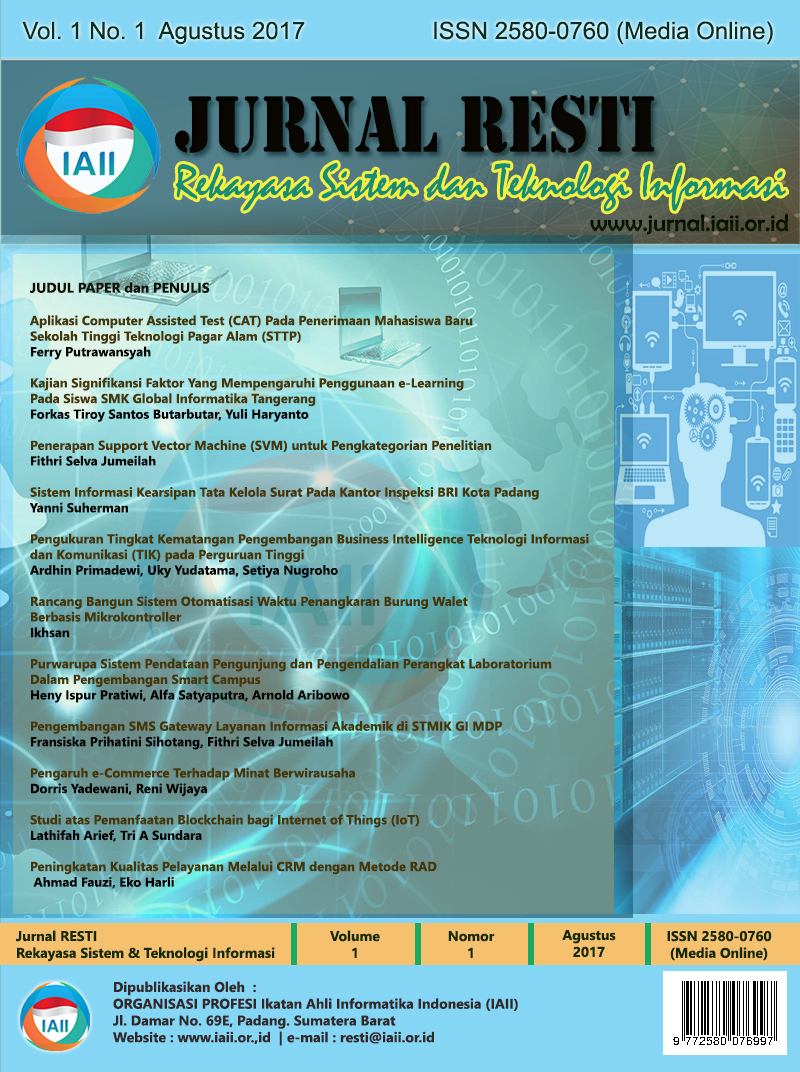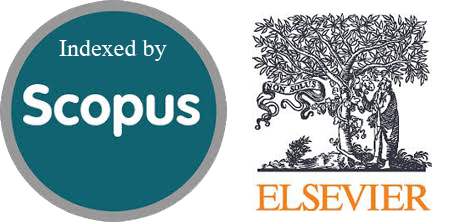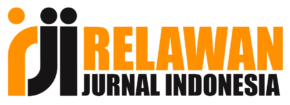Purwarupa Sistem Pendataan Pengunjung dan Pengendalian Perangkat Laboratorium Dalam Pengembangan Smart Campus
Abstract
The laboratory visitors data collection system serves as a timestamp data collection of laboratory visitors, and the control system is set for controlling electrical devices such as air conditioners, lights, and door locks inside the laboratory room according to the visitors amount, both are integrated as one system for implementing the development of Smart Campus and supporting conveniences and security for Lecturers, staff and students. The system uses hardware such as door lock solenoid, relay board, RFID reader, serial-cables and Arduino microcontrollers. Some software are used such as Node.js scripts (JavaScript runtime environment) as the central logic and communication, one Arduino microcontroller programmed with Arduino software program, and another Arduino microcontroller is embedded with firmware Firmata and application software such as server XAMPP for web pages using Bootstrap framework and Javascript library such as AngularJS, JQuery and Javascript Bootstrap. Furthermore, MySQL is used as a database by using a serial protocol, and then WebSocket and Johnny-Five Framework are used as a complement system solution. Overall integration of the systems is expected to run smoothly as designed.
Downloads
References
[2] Rai, R., 2013. Socket.io Real-time Web Application Development. 1st ed. Birmingham: Packt Pub.
[3] Internet of things agenda. Rouse, M. RFID (radio frequency identification). Updated April 2007. Available at: http://internetofthingsagenda.techtarget.com/definition/RFID-radio frequency-identification. [Accessed: Nov. 14, 2016].
[4] Northwestern University Mechatronics Design Laboratory, 2006. Available at: http://mechatronics.mech.northwestern.edu. [Accessed: Nov. 14, 2016]
[5] Github. Firmata Protocol Documentation.
Available at: https://github.com/firmata/protocol. [Accessed: Nov. 14, 2016]
[6] Chaniotis, I.K., Kyriakou, K.I.D., Tselikas, N.D., 2015. Is Node.js a viable option for building modern web applications? A performance evaluation study. Springer
[7] M Cantelon, M Harter, TJ Holowaychuk, N Rajlich. 2014. Node.js in Action. Available at: toc.dreamtechpress.com
[8] Daggett, M.E., 2013. JavaScript IRL. Springer
[9] Node.js Foundation, 2016. Working with Different Filesystems. Available at: https://nodejs.org/en/docs/guides/working-with-different-filesystems [Accessed: Nov. 14, 2016]
[10] Standard ECMA-414. 2016. ECMAScript Specification Suite .2nd ed. Available at: https://www.ecma-international.org/publications/standards/Ecma-414.htm [Accessed: Nov. 16, 2016]
[11] Bell, C., 2014. MySQL High Availability: Tools for Building Robust Data Centers. 2nd ed. Sebastopol, CA: O’Reilly Media.
[12] Skvorc, Bruno, 2015. 1st ed. Jump Start PHP Environment.Collingwood, Australia: SitePoint Pty.
[13] Lombardi, Andrew, 2015. 1st ed. Websocket. Sebastopol, CA: O’Reilly Media.
[14] Frenzel, Louis., 2016. Handbook of Serial Communication Interfaces. Waltham, MA: Elsevier.
[15] Henderson, H., 2016. Encyclopedia of computer science and technology .2nd ed. New York, NY: Facts On File
[16] Firmata Lib rary. 2016. Available at: https://www.arduino.cc/en/Reference/Firmata [Accessed: Nov.14, 2016]
Copyright (c) 2017 Jurnal RESTI (Rekayasa Sistem dan Teknologi Informasi)

This work is licensed under a Creative Commons Attribution 4.0 International License.
Copyright in each article belongs to the author
- The author acknowledges that the RESTI Journal (System Engineering and Information Technology) is the first publisher to publish with a license Creative Commons Attribution 4.0 International License.
- Authors can enter writing separately, arrange the non-exclusive distribution of manuscripts that have been published in this journal into other versions (eg sent to the author's institutional repository, publication in a book, etc.), by acknowledging that the manuscript has been published for the first time in the RESTI (Rekayasa Sistem dan Teknologi Informasi) journal ;








